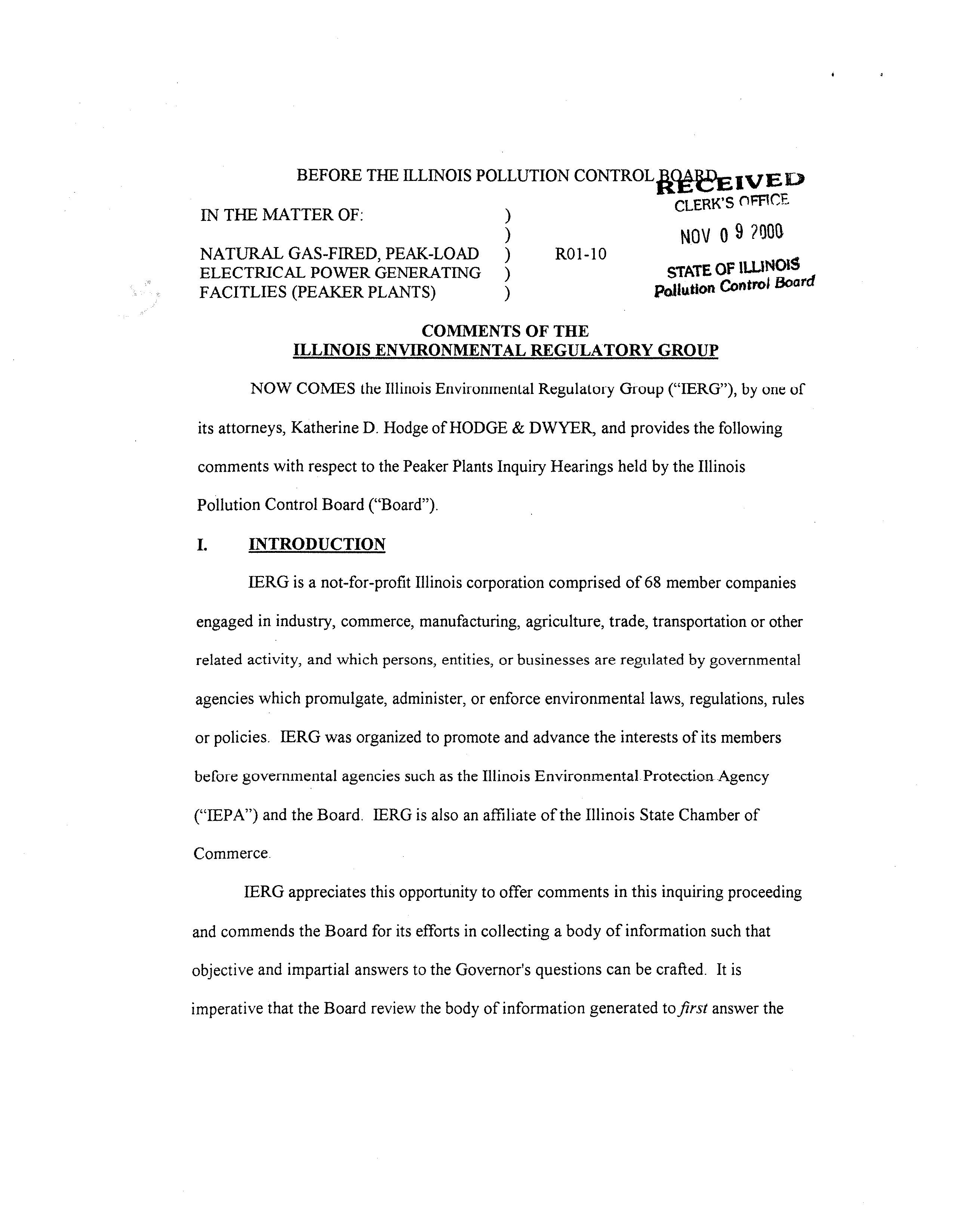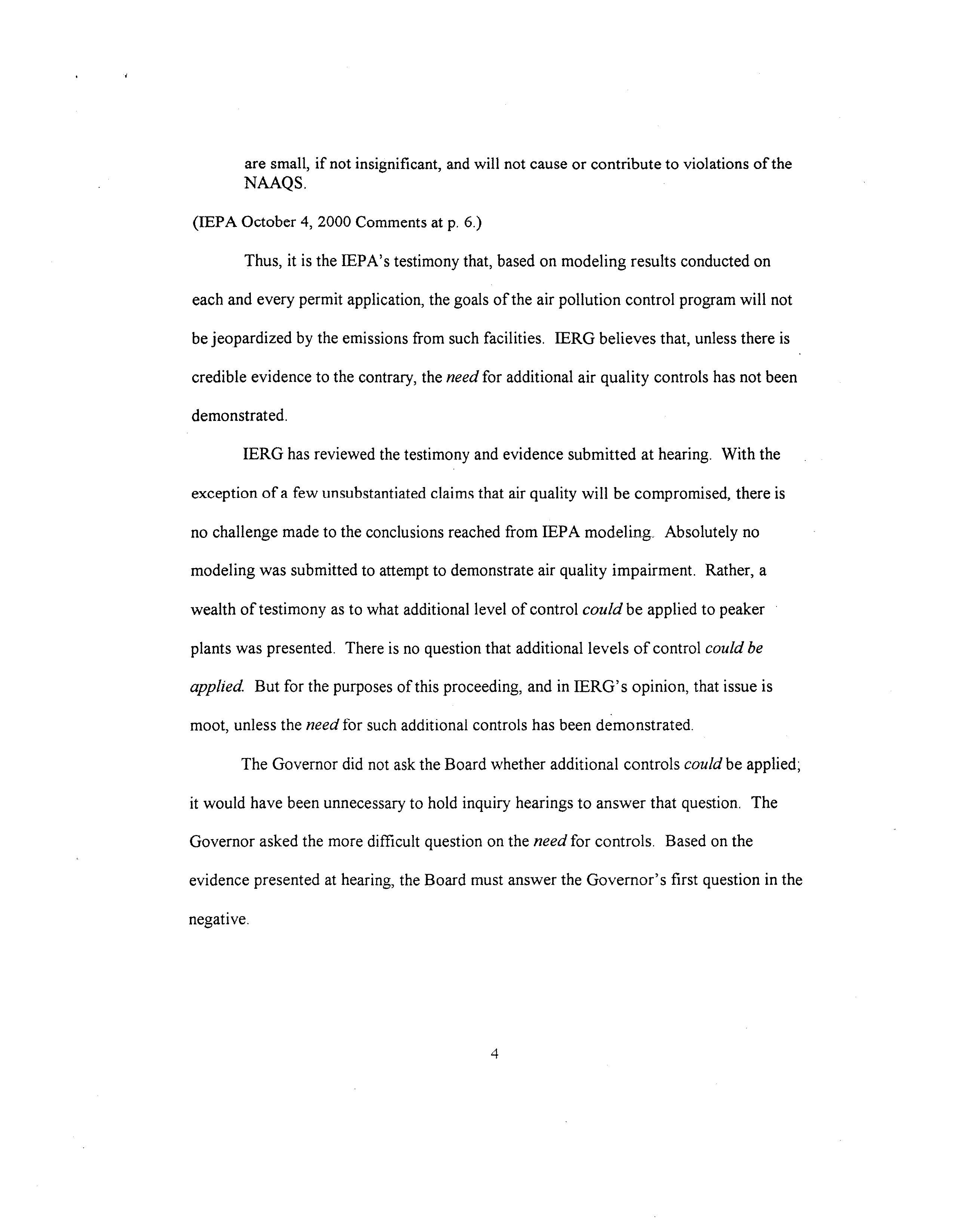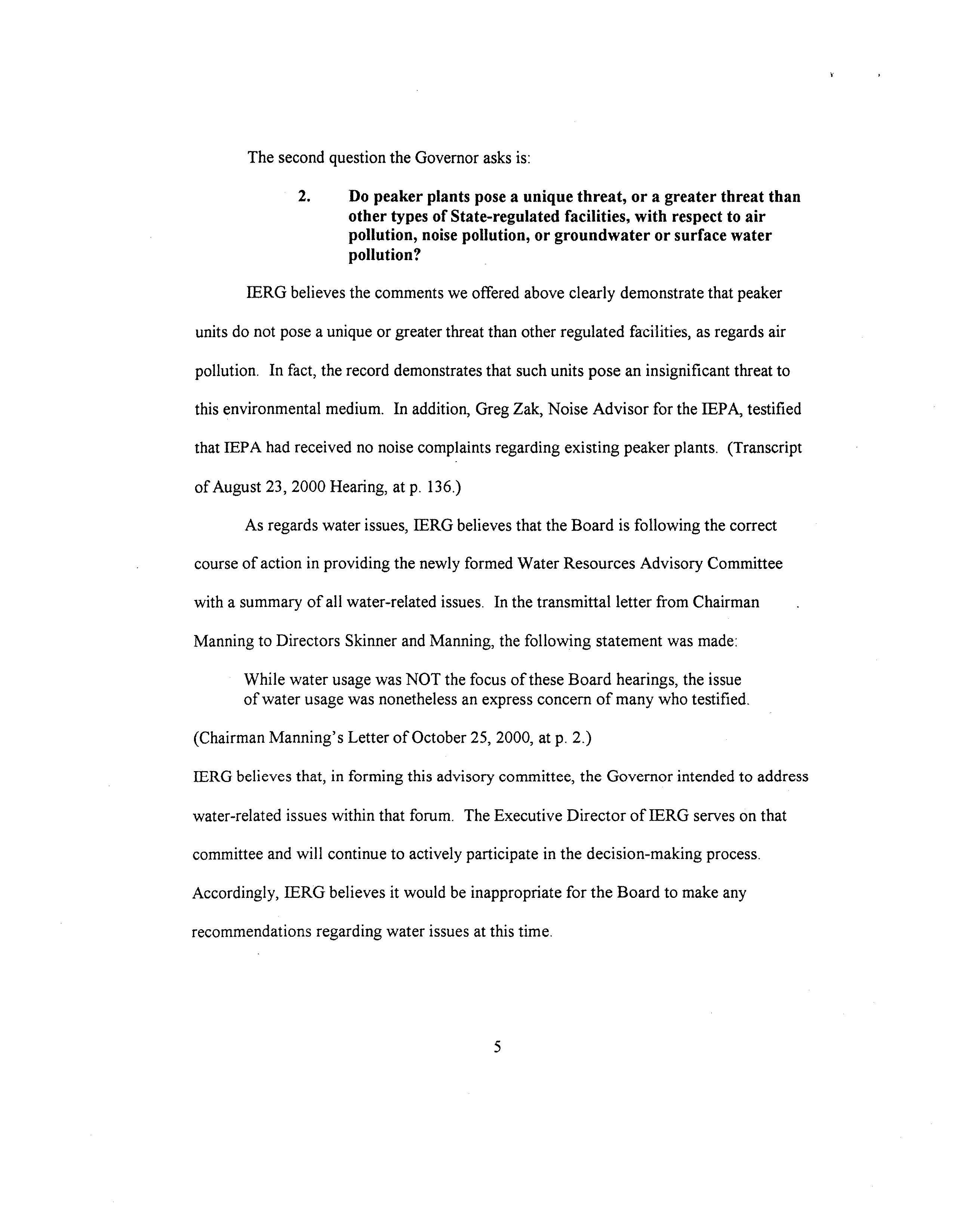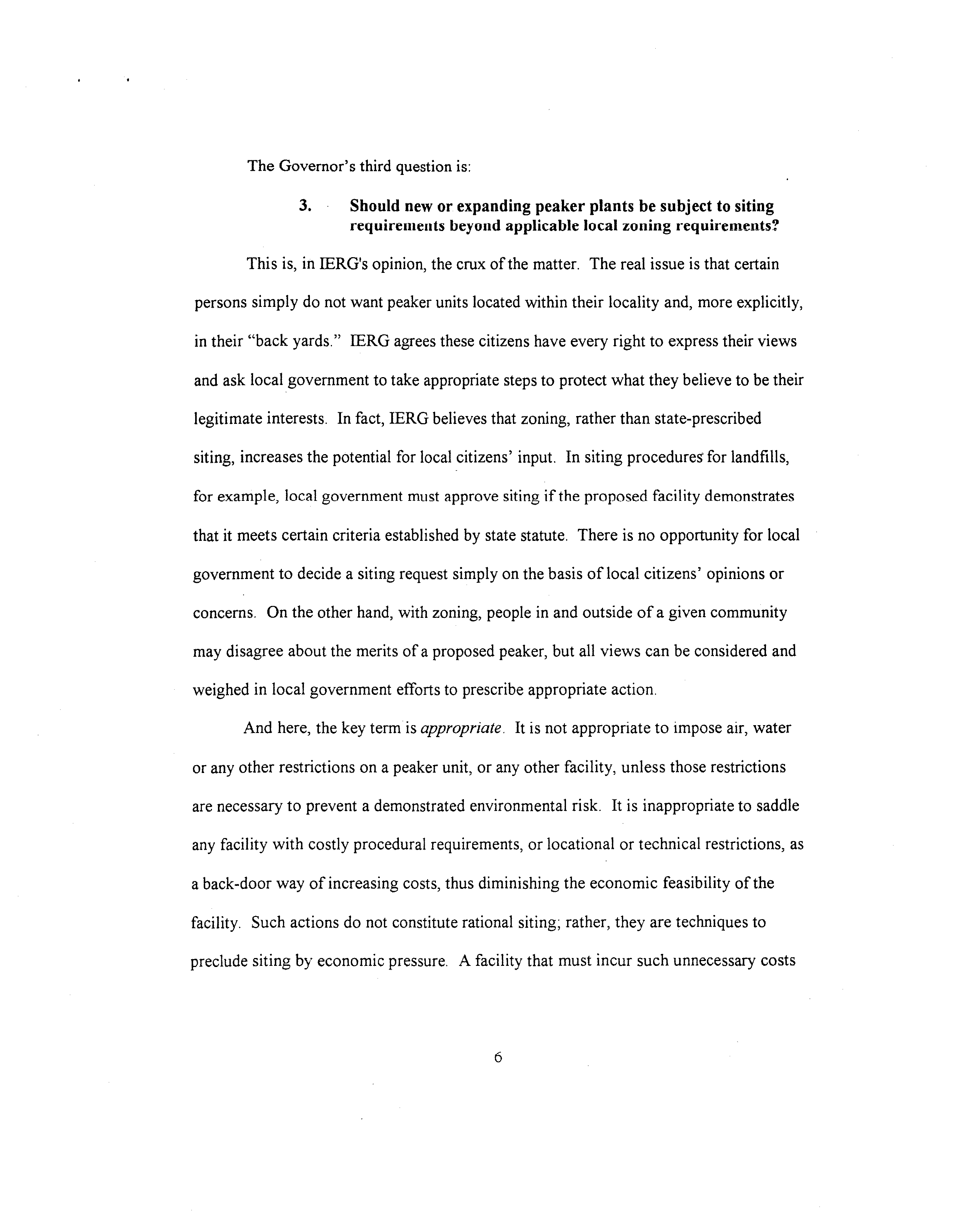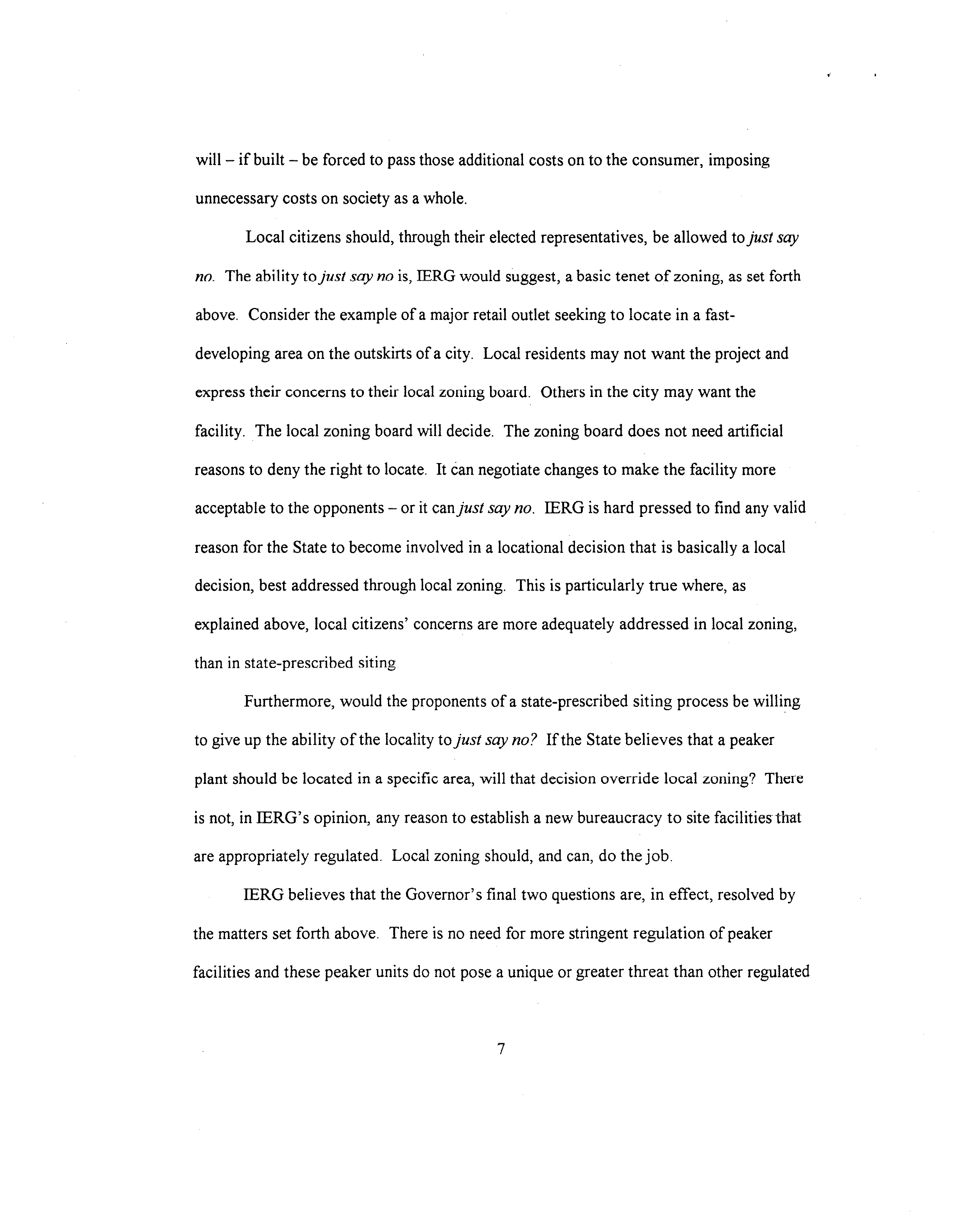IN THE MATTER
OF:
)
NATURAL GAS-FIRED, PEAK-LOAD
ELECTRICAL POWER GENERATING
FACILITIES (PEAKER PLANTS)
RECEJ
VEt
CLERR’S
OFFICE
NOTICE OF FILING
TO:
Ms. Dorothy M. Gunn
Clerk ofthe Board
Illinois Pollution Control Board
James R. Thompson Center
100 West Randolph Street
Suite
11-500
Chicago, Illinois
60601
(VIA FIRST CLASS
MAIL)
PLEASE TAKE NOTICE that I have filed today an original and nine copies of
the COMMENTS
OF THE ILLINOIS ENVIRONMENTAL REGULATORY GROUP,
copies ofwhich are herewith served upon you.
Respectftilly submitted,
Dated:
November 6, 2000
ILLINOIS ENVIRONMENTAL
REGULATORY GROUP,
By:
ne of Its Attorneys
Katherine D,
Hodge
HODGE & DWYER
3150 Roland
Avenue
Post Office Box 5776
Springfield, Illinois
62705-5776
(217)
523-4900
Karen L. Bernoteit
Illinois Environmental Regulatory Group
215 East Adams Street
Springfield, Illinois
62701
(217) 522-5512
BEFORE THE ILLINOIS POLLUTION CONTROL BOARD
)
)
)
)
NOV
09
2000
STATE
OF IWNOIS
Pollution
Control
Boar
RO 1-10
/~.~‘(7
THIS
FILING
SUBMITTED
ON RECYCLED PAPER
BEFORE THE ILLINOIS POLLUTION CONTROL~(~gjVE~)
“LERK’S
nFF~CE
IN THE MATTER OF:
)
)
NOVO9200~
NATURAL GAS-FIRED
PEAK-LOAD
)
ROl-lO
ELECTRICAL POWER GENERATING
)
STATE OF IWt4OIS
FACITLIES
(PEA.KER PLANTS)
)
poUutlon
Control
Øoard
COMMENTS OF THE
ILLINOIS ENVIRONMENTAL REGULATORY GROUP
NOW COMES
the Illinois Envirorunerital Regulatory Group (“IERG”), by one of
its
attorneys, Katherine D. Hodge of HODGE & DWYER, and provides the following
comments with respect to the Peaker Plants Inquiry Hearings held by the Illinois
Pollution Control Board (“Board”).
I.
INTRODUCTION
IERG
is a not-for-profit Illinois corporation comprised of 68 member
companies
engaged in industry, commerce, manufacturing, agriculture, trade, transportation or other
related activity, and which persons, entities, or businesses are regulated by governmental
agencies which promulgate, administer, or enforce environmental laws,
regulations, rules
or policies.
IERG was organized to promote and advance the interests of its members
before governmental agencies such as the Illinois EnvironmentalProtectionAgency
(“JEPA”)
and the Board.
IERG is also an affiliate of the Illinois State Chamber of
Commerce.
IERG appreciates this opportunity to offer comments in this inquiring proceeding
and commends the Board for its efforts in collecting abody of information such that
objective and impartial answers to the Governor’s questions can be crafted.
It is
imperative that the Board review the body of information generated to
first
answer the
specific,questions asked by the Governor.
Only
after arriving at
answers to those specific
questions should the Board turn its attention to recommendations as to imposing any
further requirements on peaker plants.
IERG,
on reviewing the testimony and questions presented at the public hearings,
is concerned that the issues of
needfor action
and of
available actions
have become
blurred.
In our final comments on this matter, ERG
wishes to point out the differences
between these two issues as they relate to air pollution controls.
We also will comment
on the issue of zoning, as opposed to more formal
siting programs, reiterate our prior
concerns as to the definition of peaker plants, and offer comment on the need for peak
power in the new age of deregulation.
II.
COMMENTS
A.
Governor Ryan’s Inquiries
The first question the Governor asks is:
1.
Do peaker plants need
to
be regulated
more strictly
than
Illinois’
current air
quality
statutes and regulations
provide?
The answer to this question
lies
in testimony and responses to questions relating
to air quality impacts.
How
is one to determine ifthere is a
need
for additional
regulations?
ERG
believes that the need for additional
regulations, or lack thereof, is a
function of whether the goals of air pollution control are, or are not, being achieved.
The
only way to determine if such goals are being achieved
—
or if the presence of new peaker
units will somehow compromise such goals
—
is to look at the potential
effect of peaker
plants
on ambient air quality standards and PSD increments.
In fact, this type of analysis
was the primary thrust of the testimony presented
by IEPA
witnesses
(~,
Testimony of
7
Thomas Skinner, Christopher Romaine and Robert
Kaleel).
(Transcript of August 23,
2000 Hearing, at pp. 48-130.)
Mr. Kaleel’s testimony and attached exhibits are of particular importance on this
issue.
Mr. Kaleel’s testimony was based
on the results of modeling conducted by the
IEPA as part of the air permitting process for peaker plants,
as well as for attainment
demonstration purposes.
This modeling is
the only
scientific evidence presented as to the
effects, or lack thereof, of the air quality impacts ofpeaker plants.
Mr. Kaleel testified
that the results of the studies reviewed to date have shown, to the Agency’s satisfaction,
that the natural-gas-fired peakers permitted thus far will not threaten the NAAQS or PSD
for NO2,
PM1O, SO2
and CO:
(Transcript of August
23, 2000 Hearing, at pp.
115-117.)
As to ozone
standards, Mr.
Kaleel testified that the expected emissions from the natural
gas fired turbines, or peakers, will
not greatly affect the State’s ability to demonstrate
attainment ofthe
1-hour standard.
Mr. Kaleel also stated that the model’s response to
projected emissions increases is small relative to the improvements in ozone
air quality
achieved to date and to improvements expected in the coming years from control
programs yet to be implemented.
(Transcript of August 23, 2000 Hearing, at pp.
128-
130.)
Following the 1EPA’s testimony, the Board correctly asked a number of follow-up
questions,
in writing, to probe the question of localized air quality effects.
(Illinois
Pollution Control Board Order of September 25,
2000
Order, at
p.
1.)
In response to
Board question # 2, the EPA
stated:
The required analyses
are conservative
...
and address impacts at locations where
peak impacts are expected to occur,
even as close as the source’s fence lines.
The
modeling has consistently demonstrated that the air quality impacts ofthe peakers
are small, if not insignificant, and will not cause or contribute to violations ofthe
NAAQS.
(IEPA October 4, 2000 Comments at p.
6.)
Thus, it
is the EPA’s
testimony that, based on
modeling results conducted on
each and every permit application, the goals ofthe air pollution control program will
not
be jeopardized by the emissions from such facilities.
ERG
believes that, unless there is
credible evidence to the contrary,
the
need for
additional
air quality controls has not been
demonstrated.
IERG has reviewed the testimony and evidence submitted at hearing.
With the
exception of a few unsubstantiated claims that air quality
will be compromised, there is
no challenge made to the conclusions reached from EPA
modeling.
Absolutely no
modeling was submitted to attempt to demonstrate air quality impairment.
Rather, a
wealth of testimony
as to what additional
level of control
could
be applied to peaker
plants was presented.
There is no question that additional
levels of control
could be
applied
But for the purposes ofthis proceeding,
and in ERG’s
opinion, that issue is
moot, unless the
need
for such additional
controls has been demonstrated.
The Governor did
not
ask the Board whether additional
controls
could
be applied;
it would have been unnecessary to hold inquiry hearings to answer that
question.
The
Governor asked the more difficult question
on the
need
for controls.
Based on the
evidence presented at hearing,
the Board must answer the Governor’s first question
in the
negative.
4
The second question the Governor asks is:
2.
Do peaker plants pose a unique threat, or a greater threat than
other types of State-regulated
facilities, with respect to air
pollution, noise pollution, or groundwater or surface water
pollution?
ERG
believes the comments we offered above clearly demonstrate that peaker
units do
not pose a unique or greater threat than other regulated facilities, as regards air
pollution.
In fact, the record
demonstrates that such units pose an insignificant threat to
this environmental medium.
In addition, Greg Zak, Noise Advisor for the IEPA, testified
that IEPA had received
no
noise complaints regarding existing peaker plants.
(Transcript
of August 23, 2000 Hearing, at p.
136.)
As regards water issues, ERG
believes that the Board is following the correct
course of action in providing the newly
formed Water Resources Advisory Committee
with a summary of all water-related issues.
In the transmittal letter from Chairman
Manning to Directors Skinner and Manning, the following statement was made:
While water usage was NOT the focus ofthese Board hearings, the issue
ofwater usage was nonetheless an express concern of many who testified.
(Chairman Manning’s Letter of October
25,
2000, at p. 2.)
ERG
believes that,
in forming this advisory committee, the
Governor intended to address
water-related issues within that forum,
The Executive Director of IERG serves on that
committee and will continue to actively participate in the decision-making process.
Accordingly, ERG
believes
it would be
inappropriatefor the Board to make any
recommendations
regarding water issues at this time.
5
The Governor’s third question
is:
3.
Should
new or expanding peaker plants be subject to siting
requirements beyond applicable local zoning require~neuts?
This
is,
in ERG’s
opinion, the crux of the matter.
The
real issue is that certain
persons simply do not
want peaker units located within their locality
and, more explicitly,
in their “back yards.”
ERG
agrees these citizens have every right to express their views
and ask local government to take appropriate
steps to protect what they believe to be their
legitimate interests.
In fact, ERG
believes that zoning, rather than
state-prescribed
siting,
increases the potential for local citizens’ input.
In siting procedures for landfills,
for example, local government must approve siting if the proposed facility demonstrates
that it meets certain criteria established by
state statute.
There is no opportunity for local
government to decide a siting request simply on the basis of local citizens’ opinions or
concerns.
On the other hand,
with zoning, people in and outside of a given community
may disagree about the merits of a proposed peaker,
but all views can be considered and
weighed in local government efforts to prescribe appropriate action.
And here,
the key term
is
appropriate.
It is not appropriate to impose air, water
or any
other restrictions on a peaker unit, or any other facility, unless those restrictions
are necessary to prevent a demonstrated environmental risk.
It is inappropriate to saddle
any facility with costly procedural requirements, or locational
or technical restrictions, as
a back-door way of increasing costs, thus diminishing the economic feasibility ofthe
facility.
Such actions
do
not constitute rational siting; rather, they are techniques to
preclude siting by economic pressure.
A facility that must incur such unnecessary costs
6
will
—
if built
—
be forced to passthose additional
costs on to the consumer, imposing
unnecessary costs on
society
as awhole.
Local citizens should, through their elected representatives, be allowed
tojustsay
no.
The ability
tojustsay no
is, ERG
would suggest, a basic tenet of zoning,
as set forth
above.
Consider the example of a major retail outlet seeking to locate in a fast-
developing area on the outskirts of a city.
Local residents may not want the project and
express their concerns to their local zoning board.
Others in the city may want the
facility.
The
local zoning board will decide.
The zoning board does
not need artificial
reasons to deny the right to locate.
It can negotiate changes to make the facility more
acceptable to the opponents
—
or it
can
just say no.
ERG
is hard pressed to
find any valid
reason for the State to become involved in a locational decision that
is basically a local
decision, best
addressed through local zoning.
This is particularly true where,
as
explained above, local citizens’ concerns
are more adequately addressed
in local zoning,
than in
state-prescribed siting
Furthermore, would the proponents of a state-prescribed siting process be willing
to give up the ability of the locality to
just say no?
Ifthe State believes that a peaker
plant
should be located
in a specific area,
will that decision override local zoning?
There
is not, in ERG’s
opinion, any reason to establish a new bureaucracy to site facilitiesthat
are appropriately regulated.
Local zoning should,
and can,
do the job.
ERG
believes that the Governor’s final
two questions are,
in effect, resolved by
the matters set forth above.
There is no
need for more stringent
regulation of peaker
facilities and these peaker units do
not
pose a unique or greater threat than other regulated
7
facilities.
The concerns raised in these proceedings are best addressed by
local zoning,
rather than additional
state regulation.
B.
Additional Considerations
ERG
would like to pose two additional
questions and answers that are vital to
this inquiry proceeding,
as set forth below.
1.
What
is a peaker plant?
D.K.
Hirner,
ERG’s
Executive Director, previously testified at the Board’s
hearing on this matter.
(Transcript of August 24,
2000 Hearing,
at pp.
308-313)
Tn that
testimony, ERG
stressed that the Board should clearly define the type ofunits that are to
be the subject of any recommendations that result from these hearings.
Our concern at
that time was that an entire universe of industrial steam and/or electric generation
facilities could be treated as peaker plants.
After review of the testimony, our concerns in
this area have increased.
Once again,
the focus ofthe hearings
—
natural
gas-tired peaker plants
—
has been
obscured by
much of the testimony.
The initial motivation for these hearings was public
concern
—
justified
or not
—
that power-generating facilities that are specifically
constructed to supply only electric power, come on-line quickly, and produce power only
in times of peak demand, would create unique problems for a community.
During the
course ofthe testimony, this scope became blurred with extensive discussion regarding
combined-cycle,
co-generation and even base-load facilities.
ERG
would submit that if
the hearings were intended to cover issues regarding such a wide universe of power
generation facilities, the testimony would have been much more detailed and
comprehensive.
S
As the Boardwill be issuing an
informational
order
in the near future,
it
is
imperative that the Board’s order precisely define the types of facilities that are the target
of any recommendations.
Failure to do
so risks the Board’s recommendations
being
misunderstood and thus misapplied in
future
legislative or regulatory initiatives,
As
noted in IERG’s prior testimony
in this matter, including industrial co-generation
facilities in the definition of “peaker plant,” either intentionally or by
failure to
adequately define “peaker plant,” could impose potentially severe
and unnecessary
impacts on the business community.
2.
How
does the prospect of added environmental regulation
square with Illinois’
adopted policy
to
deregulate the utility
industry and promote free competition?
Only a few years ago, the General Assembly
passed landmark legislation in the
area of electric deregulation.
Illinois
is not the first state to
do so,
nor assuredly, will
it be
the last.
The primary motivation for deregulation is the desire to lower the cost of the
goods or services provided, by
substituting a competitive marketplace for a regulated
monopoly.
In virtually
all
cases,
be
it
air fares, long distance telephone charges or
trucking, the costs have decreased dramatically due to deregulation. While the transition
will undoubtedly have problems, that is exactly why the General Assembly allowed for
an extended period of transition. During that transition period,
a number of events
should
occur. Among those events
will
be the private sector identifying areas of need (in this
case for peak power)
and providing the facilities and infrastructure to meet that need.
Prior to
deregulation, public utility companies had an obligation to provide power;
the State, through the Illinois Commerce Commission,
was authorized to issue and
approve the construction ofa new power generating facility through certificates of
9
necessity,
and in return,
the public utility received a guaranteed rate of return.
After
deregulation,
private utility companies may construct facilities to deliver power.
Private
utility companies
must obtain all
applicable environmental and-other permits
and ask
their shareholders to assume the profit or loss risks should the decision to construct be
faulty.
The intended result is that, eventually, supply and demand will balance, resulting
in the consumer getting
electricity at a fair price and the private utility earning a fair rate
of return.
ERG’s
concern in this regard
is that
each time
unnecessary
regulatory
constraints are placed on a competitive entity, the laws of competition are skewed and
everyone loses.
Either consumers will pay a higher price to compensate for additional
regulatory costs or the utility
will
opt not to construct a necessary
facility resulting
in a
shortfall in supply
—
and thus higher prices will follow.
The concern raised
by many at hearing is that there are too many facilities being
planned, or permitted, or (possibly)
constructed, relative to the demand for peak power.
Quite frankly, this should not
be a concern.
In fact, ifthis is indeed the case, the laws of
supply
and demand say that the consumer will be the big winner while the environment
will
not suffer as a result of over-capacity.
Electric power production differs from the
manufacture of “widgets” in a fundamental way.
While one may overbuild and
stockpile
widgets, with the attendant environmental impact of each additional widget being
produced, one cannot
stockpile kilowatts in the back yard.
Thus, ifthere are too many
peaker plants built, only
those willing to produce the needed power at the lowest possible
cost will operate.
The remaining facilities may well be there, but they will have a zero
environmental impact.
The shareholders will
suffer, not the consumer or the
10
environment.
The competitive marketplace will
deal with this situation.
Accordingly,
while ERG
can understand the concerns of residents
in the areas regarding excess
capacity, upon
close analysis,
webelieve such concerns may,
in many cases, be
unwarranted.
ifi.
CONCLUSION
ERG
appreciates
the opportunity to participate inthis proceeding.
ERG
respectfully requests that the Board consider and act favorably on the comments set forth
herein.
Respectfully submitted,
ILLINOIS ENViRONMENTAL
REGULATORY GROUP,
By:_______
One of Its Attorneys
Dated:
November 6, 2000
Katherine D. Hodge
N. LaDonna Driver
HODGE &
DWYER
3150 Roland Avenue
Post Office Box 5776
Springfield, Illinois
62705-5776
(217) 523-4900
Karen Bernoteit
Illinois Environmental Regulatory Group
215 East Adams Street
Springfield, Illinois 62701
(217) 522-5512
IER(J:OOI/R-Dockets/RO 1-10 Comments of IERG
11


